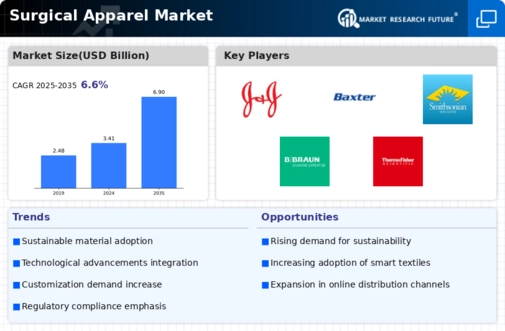Market Share
Surgical Apparel Market Share Analysis
In the dynamic landscape of the Surgical Apparel Market, market share positioning strategies play a pivotal role in determining the success of companies within the industry. These strategies involve a careful blend of product differentiation, pricing, and targeted marketing efforts to carve out a distinct space in the competitive arena. One common approach is emphasizing product quality and innovation, as healthcare professionals seek reliable and cutting-edge surgical apparel to ensure patient safety and comfort. Companies that invest in research and development, constantly refining and upgrading their product offerings, often gain a competitive edge and secure a larger share of the market.
Another key factor in market share positioning is pricing strategy. Some companies focus on providing cost-effective solutions, catering to budget-conscious healthcare facilities without compromising on quality. This approach aims to capture a substantial share of the market by appealing to a broad customer base. Conversely, premium pricing strategies target a niche market that values high-end features, superior materials, and advanced technologies. Such companies position themselves as industry leaders, attracting customers who prioritize top-tier surgical apparel and are willing to pay a premium for it.
Furthermore, effective marketing and branding strategies are critical in shaping market share positioning. Companies invest in building strong brand identities, leveraging both traditional and digital channels to create awareness and foster customer loyalty. Strategic partnerships with healthcare institutions, endorsements from key opinion leaders in the medical field, and targeted advertising campaigns all contribute to establishing a positive brand image. This, in turn, helps in securing a larger market share by influencing purchasing decisions and building trust among end-users.
In addition to differentiation, pricing, and marketing, geographic positioning is another dimension of market share strategies in the Surgical Apparel Market. Companies may choose to focus on specific regions or countries, tailoring their products to meet the unique needs and regulations of those markets. This localized approach allows companies to gain a deeper understanding of regional preferences, adapt to regulatory requirements, and establish strong distribution networks. As a result, they can capture a significant market share in specific geographical areas, positioning themselves as leaders in those regions.
Collaboration and partnerships also play a crucial role in market share positioning. Forming alliances with distributors, suppliers, or other healthcare industry stakeholders can enhance a company's reach and influence. By aligning with strategic partners, companies can tap into new markets, access additional distribution channels, and benefit from shared resources and expertise. These collaborative efforts contribute to a more robust market presence and strengthen a company's position against competitors.









Leave a Comment